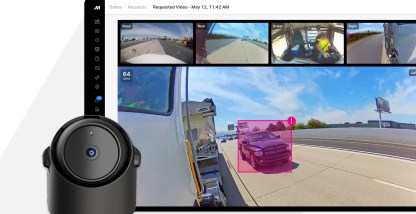Diagnostic Trouble Codes are codes designed to alert a driver and fleet manager when a vehicle malfunctions. They’re also known as DTC codes. They were originally created by the Society of Automotive Engineers to help vehicles comply with emission regulations.
Today’s vehicles carry an onboard diagnostics (OBD) system. It monitors the vehicle for any possible issues with the engine or the vehicle’s operation. The onboard diagnostics system is connected to a vehicle’s engine control unit (ECU), which controls various functions within the engine.
When a malfunction is detected by the onboard diagnostics system, a trouble code is generated. This will normally alert the driver through an indicator on the vehicle’s instrument panel. When a vehicle is properly equipped, an alert can also be delivered right to the fleet manager. Or even to a fleet’s maintenance department through vehicle diagnostics software.
DTC codes and how they work
DTC codes help fleet managers and drivers understand potential issues that require attention so that vehicles are ideally maintained. Each DTC code corresponds to a particular fault detected in a vehicle. When the OBD detects an issue that requires attention, it’ll activate the corresponding code.
The best source for DTC meanings is the dealer that sold or leased the truck to you or the manufacturer who made it. Some DTCs are specific to the vehicle. You can often download the complete list to a device and access it at any time. This comes in especially handy when cellular service isn’t available.
A much more efficient option is to have vehicle diagnostics software installed in your vehicle. It’ll not only monitor DTC codes through a direct connection to onboard vehicle diagnostics, but will also alert you to exactly what that code means. Here are some code descriptors to help you understand them.
A DTC code is five characters long. The first character is a letter that indicates which part of the vehicle has a malfunction:
- P: Powertrain, which includes the engine, transmission, and associated accessories
- C: Chassis, which covers mechanical systems and functions: steering, suspension, and braking
- B: Body, which includes parts mainly found in the passenger compartment area
- U: Network and vehicle integration, which are functions managed by the onboard computer system
The second character is a number, usually a 0 or 1. 0 is a generic code. And 1 means a manufacturer-specific code.
The third character is also a number that deals with many different types of issues. For powertrain codes, this number will indicate which vehicle subsystem has a fault.
- 0: Fuel and air metering and auxiliary emission controls
- 1: Fuel and air metering
- 2: Fuel and air metering — injector circuit
- 3: Ignition systems or misfires
- 4: Auxiliary emission controls
- 5: Vehicle speed control, idle control systems, and auxiliary inputs
- 6: Computer and output circuit
- 7: Transmission
You may also see an A, B, or C, which can refer to hybrid propulsion systems.
For other families of codes, please refer to the definitions provided by your manufacturer.
The fourth and fifth characters are also numbers. They define the exact problem being encountered. It can be a number between 0 and 99. Here’s an example of a complete code. P0782 means powertrain, generic, transmission, and 2-3 shift malfunction.
Crucial diagnostic trouble codes
Fault codes are the most precise method of keeping tabs on vehicle health. A vehicle’s OBD system gathers information such as engine RPM, vehicle speed, fuel usage, fault codes, and others. When this information is uploaded to a software interface, the fleet manager can efficiently monitor the performance and health of all trucks in the fleet.
DTC codes that indicate high engine temperatures and low coolant levels might indicate imminent engine failure. There are others that could point to issues that should be addressed right away. Service personnel will know what to do if they appear.
Vehicle diagnostic systems keep you informed
Without a vehicle diagnostics system, a fleet manager may have to rely on drivers or others to relay codes displayed in the vehicle. A driver or anyone else might become distracted or forget to notify you of a DTC code that needs to be addressed. You may not become aware of a serious maintenance issue. And the problem may worsen until it’s serious and make the process of vehicle fleet management more difficult.
DTC codes can be used to accurately inform mechanics or other repair personnel of issues that need to be addressed. That way, a mechanic will know what problems a vehicle has and ensure they’re completely addressed.
Making the DTC process worry-free
With an efficient vehicle diagnostics system, maintenance issues can be monitored and caught early. Before they become serious issues.
When you employ a vehicle diagnostics software system, DTC codes can go straight to the fleet desk. A dispatcher can inform the driver how to handle the issue. At the same time, another vehicle can be sent to take over the load.
A driver should never ignore the check engine light when it comes on and stays on. A check engine light or malfunction indicator lamp (MIL) that stays lit is an indicator of a critical problem with your vehicle.
If a driver sees such an indicator light, and their company has an onboard vehicle diagnostics system installed, they should contact their fleet manager. They should have received a fault code notification on their computer with a detailed description and can instruct the driver of the next step to resolve the issue.
Benefits of accurately monitoring DTC codes
In the past, drivers and fleet managers had to depend on guesswork to keep vehicles in good repair. “That funny noise,” a slip in the transmission, or temperature running a little higher than normal. These were clues that something was wrong. The only solution was to take time out and have the vehicle looked over by a mechanic or repair person.
Today, the right vehicle diagnostics system will alert drivers and fleet managers as soon as there’s a problem. Whether or not the driver can hear it or feel it.









